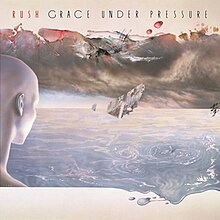Grace Under Pressure (Rush album)
| Grace Under Pressure | ||||
|---|---|---|---|---|
 |
||||
| Studio album by Rush | ||||
| Released | April 12, 1984 | |||
| Recorded | November 1983 – March 1984 at Le Studio in Morin-Heights, Quebec | |||
| Genre | ||||
| Length | 39:23 | |||
| Label | ||||
| Producer | Rush, Peter Henderson | |||
| Rush chronology | ||||
|
||||
| Singles from Grace Under Pressure | ||||
|
||||
| Professional ratings | |
|---|---|
| Review scores | |
| Source | Rating |
| Allmusic | |
| Kerrang! | (very favourable) |
| Rolling Stone | |
Grace Under Pressure is the tenth studio album by Canadian rock band Rush, released in 1984. It reached No. 10 on the Billboard 200 chart and went platinum in the US upon its initial release. The original vinyl pressing also featured a photo depicting an egg being held in a C-clamp. The cover art was painted by Hugh Syme, a collaborator with Rush since 1975, when he made the cover of "Caress Of Steel". On the back cover is a band portrait by the photographer Yousuf Karsh. Alex Lifeson once described Grace Under Pressure as the "most satisfying of all our records." Also Alex Lifeson has stated it was one of the most difficult Rush albums to make.
During the tour supporting their previous album, Signals, the members of Rush began by meeting with producer Terry Brown in Miami, informing him that they wanted to move on. Unhappy with the sound of the Signals album, they were also keen to see how they would work with someone other than Brown. Despite their decision to part ways Rush included a small tribute to him in the liner notes of Grace Under Pressure, which states "et toujours notre bon vieil ami — Broon." The quote translates to "and always our good old friend." Following Brown's amicable departure, Rush approached producer Steve Lillywhite to record the album but he ended up working with Simple Minds instead. Rush eventually produced the album themselves, with assistance from Peter Henderson, who had previously worked with Supertramp, Split Enz, Wings, Frank Zappa and King Crimson.
The album was recorded at Le Studio. Current events found in the Toronto-based newspaper The Globe and Mail inspired much of the lyrical content of the album, particularly "Distant Early Warning," "Red Lenses," and "Between the Wheels." After a few months, the mixing stage had begun, and Neil Peart discussed the details of the cover art with Hugh Syme. The band spent up to fourteen hours per day in the studio, perfecting the album's dystopian sound.
...
Wikipedia
